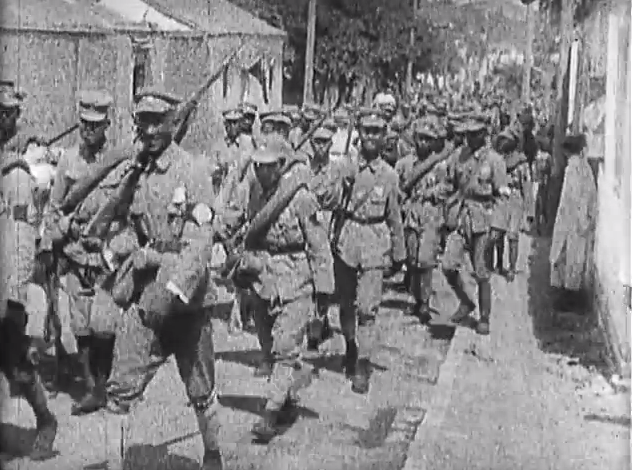 |
| KMT Army in Northern Expedition |
In 1923 Sun Yat-sen made an agreement with the Soviet Union that helped him reorganize the Nationalist Party, or Kuomintang (KMT), and provided military aid to build an army. His price was to admit members of the Chinese Communist Party (CCP) to the KMT, where many were given key posts.
Sun formed a government in Canton and died in 1925, after which the KMT split, with the pro-Communist wing in command, led by Wang Jingwei (Wang Ching-wei) and controlled by Soviet adviser Michael Borodin. Anti-Communist right-wing KMT leaders were expelled.
By July 1926 the 80,000-strong KMT army commanded by Chiang Kai-shek and led by officers trained by him in the Whampoa Military Academy was ready to take on the warlords and unify China. It confronted over 800,000 men from three warlord armies.
  |
Chiang won overwhelming victories, clearing warlord armies from lands south of the Yangzi (Yangtze) River. In his wake, Wang Jingwei moved the Nationalist capital from Canton to Wuhan. Soviet leader Joseph Stalin's goal was to use the Nationalists to defeat the warlords. But after conquering financial centers Shanghai and Nanjing (Nanking), Chiang preempted Stalin by striking first.
He purged the CCP from areas he controlled directly and established an alternate government (to Wuhan) in Nanjing in April 1927. In July the leftists in Wuhan finally realized that they were Stalin's next intended victims and, after dismissing the Soviet advisers, broke with the CCP and dissolved their "government."
Chiang resumed the Northern Expedition early in 1928. His major obstacle was Japanese intervention to prevent the unification of China. The Japanese captured provincial capital Jinan (Chinan of Shandong [Shautung] province), killing 16 Chinese diplomats sent to negotiate and several thousand civilians in the Jinan incident.
Chiang avoided war with Japan, diverting his troops' advance by a longer route. In June the Northern Expeditionary army entered Beijing (Peking) peacefully. Nanjing became China's national capital, and Beijing was renamed Beiping (Peiping), which means "northern peace." By the end of 1928, the nation was reunified, though nominally for many regions; the KMT became the ruling government, and China entered a new era.